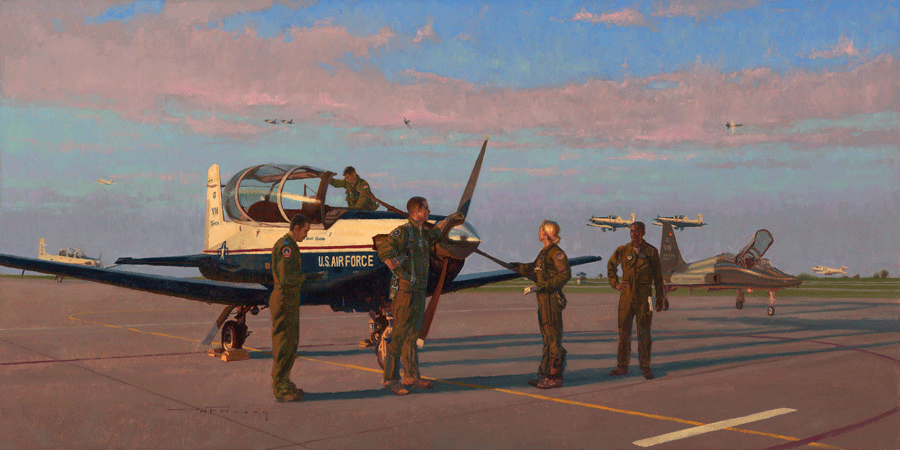
CLICK IMAGE FOR HIGH RESOLUTION

Artist: Lt. Col. Warren Neary
Medium: Oil
Date: 2017
Training military aviators to fly, fight, and win has been a foundational skill since the birth of the Air Force on 1 August 1907 as the fledgling Aeronautical Division of the Army. Throughout the following century, pilot training has remained a complex process melding a person and machine into an effective weapon for national defense. Because combat aviation places unique demands on the human body and mind, pilots must be responsible, highly motivated, and skilled. Prospective pilots undergo mental and physical challenges to ensure only the most qualified graduate to fly some of the most advanced aircraft in the world.
Initially, military pilots learned under the instruction of the famed Wright brothers. During the First World War, the United States established five flying schools growing from just 65 pilots to 1,674 by 11 November 1918.
The Air Corps’ years between 1923 and 1939, saw the intellectual development of Airpower strategy but pilot training remained remarkably consistent. When World War II broke out in Europe, it was clear that the country needed vastly more combat pilots and opened new flying schools across the country. The numbers grew quickly from 3,393 pilots who earned their wings in 1941 to 86,578 in 1944. Airpower leaders developed a new, scientific assessment program that tried to identify those students best suited for fighter aircraft and those for bomber aircraft, so they could begin specialized training in either single-engine or multi-engine aircraft earlier in pilot training.
That specialized approach continued until after the Korean War, when it changed to a generalized Undergraduate Pilot Training approach. Each student progressed from basic flight in a Cessna T-41 “Mescalero” to advanced training in a jet engine T-37 “Tweet” and the T-38 “Talon” before winning their wings and going on to specialized training in their assigned aircraft. In the mid-1990s, the Air Force went back to a specialized approach graduating about 1,300 new pilots each year. Students began in the T-37 aircraft and were then assigned to either the fighter/bomber track and flew the T-38 aircraft or the tanker/airlift track and flew the T-1, a modified Beech 400 business jet.
With a shortage of active duty pilots, the Air Force Reserve proved, again, that it was an essential element of the Total Force with many of the experienced pilots who were leaving active duty eagerly signing up to continue serving in the Reserve. After a successful test-run at Columbus and Vance Air Force Bases, the Air Force created the Associate Instructor Pilot Program in 1997 under the 340th Flying Training Group at Randolph Air Force Base, Texas. The group provides Reserve Instructor Pilots to augment the cadre of active duty instructors. The Reserve instructors bring a wealth of experience as combat pilots. More than 80-percent were active duty pilot instructors who now work in a part-time role while keeping current as full-time civilian airline pilots.
For more than 20 years, Reserve Citizen Airmen, like these from the 5th Flying Training Squadron “Spittin Kittens” at Vance Air Force Base, Oklahoma, have been an essential part of the active duty-reserve training partnership- training new pilots and helping them win their wings. Your future is in the sky and your wings are waiting.